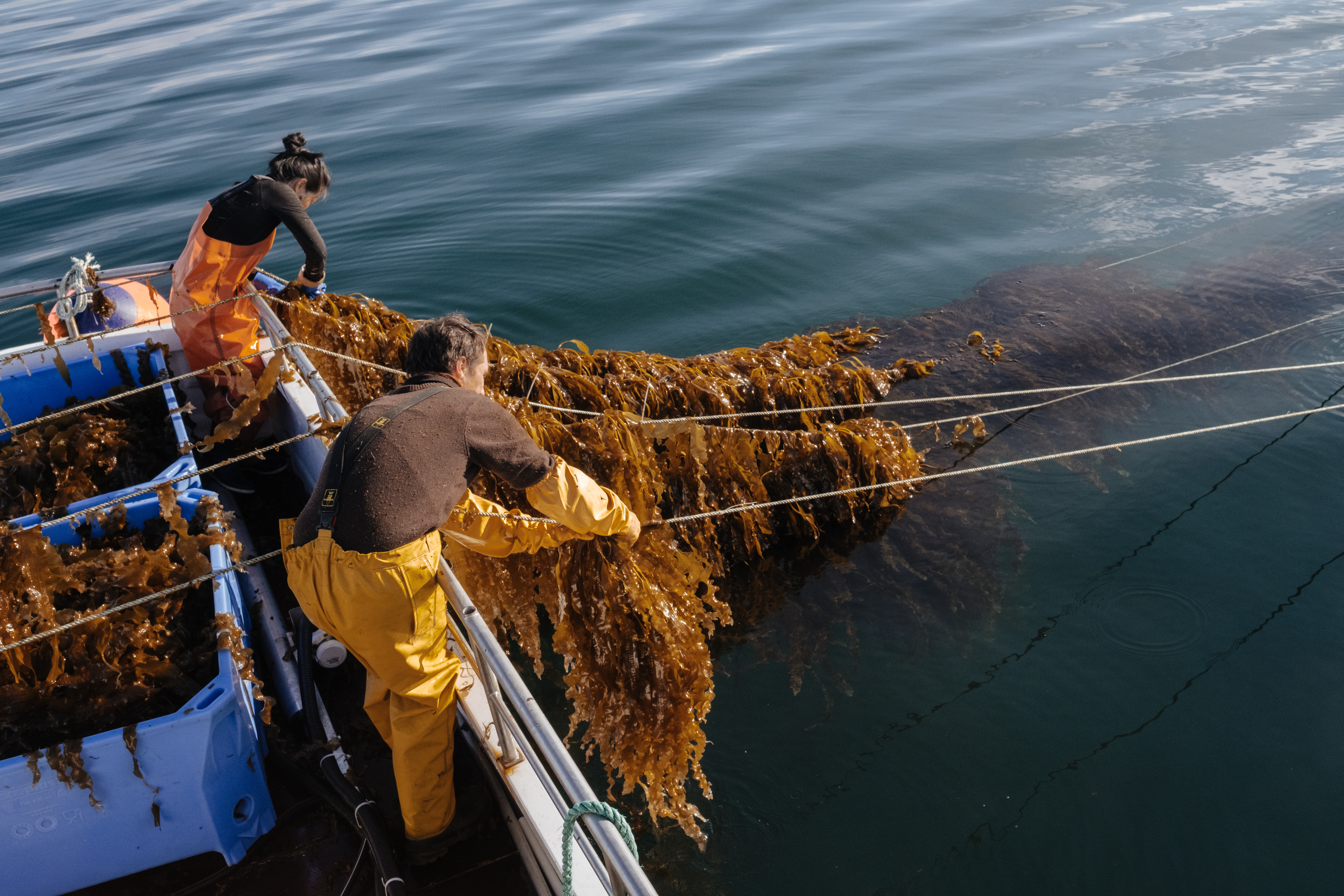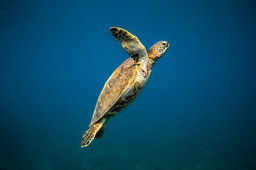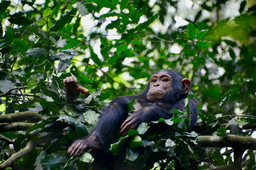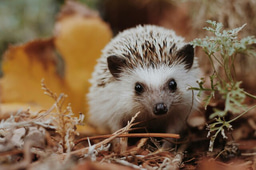Let the Seaweed Grow: from working as a graphic designer in San Francisco to starting up a seaweed farm in the Westfjords

My name is Flavia, and I am a part of WildHub’s Conservation Catalyst programme, which is all about creating engaging content through interviewing experts in the field of conservation about their expertise and experience.
Last week I had a chance to chat with Jamie Lee, co-founder and owner of Iceland’s first seaweed farm, Fine Foods Íslandica. Jamie grew up between Hong Kong and San Francisco but currently lives in Iceland, where she runs her company and advocates for sustainable seaweed farming. After graduating with a master's degree in Coastal and Marine Management from the University Centre of the Westfjords, Jamie was determined to put down roots in Iceland and change seaweed practices, so she became a seaweed farmer and now calls Hólmavík her home.
Read on to find out how Jamie is leading the way in sustainable seaweed farming in Iceland.
_____________________________________________________________________
Flavia: Could you tell me a bit about yourself? What is your background and what brought you to Iceland?
Jamie: I am originally from the US, and I grew up between Hong Kong and California. I ended up taking the art and design route growing up, and then working for a design studio in San Francisco. But I got to a point where I wanted to do something more meaningful with my life, so I quit my job and came to Iceland. I travelled around for five weeks, hitchhiking and camping solo. I met the kindest people, and my eyes met the most breathtaking landscapes I have ever seen. When I went back to the States, all I could think of was Iceland, I wanted to move here and see if the Iceland I experienced the first time as a traveller was the real deal. That’s when I found the master’s programme in Coastal and Marine Management at the University Centre of the Westfjords. As a graphic designer it would have been difficult for me in the States to get into a programme like this. That’s what makes this programme special, they welcome people from all walks of life and encourage transdisciplinary collaboration. So I moved to Iceland, and that decision changed the course of my life.
 ©Fine Foods Íslandica
©Fine Foods Íslandica
Flavia: How did you get into seaweed farming?
Jamie: Before moving to Iceland, I came across a project by an art student who was using seaweed to create biodegradable water bottles. That really sparked my interest in seaweed, particularly its use as an alternative to plastic. I went into the master’s programme wanting to develop this idea further, but as I learned more about seaweed, I realised there was so much more to it.
During my master’s I took a course in sustainable aquaculture, taught by Prof. Peter Krost, who grows mussels and seaweed himself. In this course I learned that there is actually a vast diversity of seaweed out there, each seaweed has a different life cycle and different ecosystems they thrive in and so on. I went back to the art project that first drew me to the world of seaweed and realised that the seaweed used was red seaweed which is over-harvested in Morocco and other countries. This is partly due to the high demand of agar, a jelly-like substance found in red seaweed, which is used to make petri dishes. So that made me think, if we really want to replace plastic with seaweed, we need to do it in a way that is not harmful to the environment. What type of seaweed can we use? What does the production process should look like? And how would this affect local communities? When you start using natural resources in a commercial scale you have to think more holistically.
At the time there was only one major commercial seaweed harvester in Iceland, and they relied on wild seaweed alone. Most of the seaweed supply from Europe was also from wild harvesting and being seaweed a foundation species, over-harvesting can be very harmful and potentially lead to extinction. The solution was clear to me, we had to grow it. Of course, there’s a whole lot of other things to consider when you grow seaweed and that’s what I dedicated the last 8 years to. Seaweed took over my life and I started to explore how to grow it sustainably here in Iceland and study the negative impacts that come with growing seaweed at scale. I looked into all the manuals available and started experimenting with seaweed. Meanwhile I had met a local mussel farmer in Breiðafjörður whom I eventually partnered with and really supported my journey into making Fine Foods Íslandica a reality. It was invaluable to have that local knowledge and overall support. Initially I thought that seaweed farming would be just a fun hobby but at the same time I was also looking for a way to settle in Iceland, and that's really how Fine Foods Íslandica came to be!
Flavia: What is it like to run a seaweed farm in Iceland and what are some of the challenges you face in the industry?
Jamie: While harvesting wild seaweed has a long tradition in Iceland, seaweed cultivation is new to the country. Recently there have been efforts to grow seaweed on land using fish waste for example, but to my knowledge there hasn’t been any established farm running for longer than two years. We are the first company to do the whole vertical, meaning actually finding the local seed stock, seeding the lines, taking it out to sea, releasing it, harvesting it, taking it into our own food production space, creating food products and directly selling it to customers. We don’t use the same “model” as wild seaweed harvesters, because my aim is not to have a company taking over the seaweed market in Iceland but rather to disseminate knowledge about seaweed farming and find partners to grow seaweed together.
What I am currently working on is to partner with fishermen and coastal farmers who have easy access to the sea and teach them how to grow seaweed successfully while also providing the equipment and technical support necessary. The aim is to encourage local communities to take up seaweed farming perhaps as a complementary activity alongside fishing. It is also a way to invite young people to get into seaweed farming and have a livelihood here. Ultimately, I’d like to have a decentralised farming model where we don’t have just one big farm “taking from the sea” and impacting the marine environment in one place, but rather ensure that locals can set up their own small farms with a focus on ecosystem protection and community-based food production.
 ©Fine Foods Íslandica
©Fine Foods Íslandica
Flavia: How do you see seaweed farming contributing to a more sustainable food system?
Jamie: Seaweed farming could definitely be a positive addition to increase sustainability in our food system, for example seaweed could reduce pressure on fish stock and be a viable alternative to traditional salmon farming. However we need to grow seaweed instead of harvesting from wild forests. We have to make sure that if seaweed is used as an alternative to other food sources, it is being produced sustainably. Also, how much seaweed will we need to produce in order to make a significant impact? Volume is another issue. We have to look at the full cycle, how seaweed is extracted, grown and produced. We don’t want another harmful industry taking over an existing one.
Flavia: What advice would you give to anyone wanting to enter the seaweed farming industry?
Jamie: First, set your intentions. Ask yourself why seaweed farming and what it is for, then build a system around it. Start from a humble and inquisitive place. Start studying seaweed, the biology of it, understand life cycles, when to harvest and when not to harvest, do an environmental baseline study to assess the potential harm your farm could be doing to the environment, learn about the seaweed species available in your local area or wherever you are setting up your farm, find people who can support you with local knowledge and reach out to local fishermen because even if they may not be knowledgeable about seaweed they will know about the sea. You always want to involve local communities and make sure you respect their waters and ways of living.
Lastly, please do grow seaweed sustainably! Making sustainable choices can be more costly and time-consuming, but can bring more value to your company in the long run – not just monetary but personal value. Seaweed farming is not a profitable business at the moment, but it is worth being part of the movement.
 ©Fine Foods Íslandica
©Fine Foods Íslandica
Flavia: What does the future hold for Fine Foods Íslandica?
Jamie: As I mentioned, I am currently working on engaging fishermen in cultivating seaweed and finding ways to make it profitable for them. For example, I am looking at how to repurpose seaweed waste. I have been working with a chemist to potentially use seaweed waste to produce bio stimulant. Another idea is to combine seaweed waste with other biodegradable materials to make seedling pots, which are usually made of plastic. We could make biodegradable pots by using seaweed and wool, for example, so pots could be planted straight into the ground. There is so much you can do with seaweed, and we are still learning about it.
I am also very keen on finding more collaborations, but it is hard to find the right business partners. For me collaboration can only work if it’s mutually beneficial and that is a challenge. I have been in touch with the University Centre of the Westfjords for collaboration and in fact earlier this year I applied for a grant to have two UW master’s students come train with us as interns for the summer. One student will do a mapping of the coastal resources around here and create a guide on how to sustainably harvest these resources if people were to use them. In the future we could take people on walks and guide them through the landscape, teach people about the different types of seaweed found here and how to harvest responsibly. Ideally this would contribute to ocean literacy. The other student will conduct a biodiversity study to look at the different marine animals that are attracted to our seaweed farm for shelter or foraging, and see how those differ from the species found in wild seaweed forests. The results will inform on the effects our seaweed farm has on marine life and the entire ecosystem here.
This is our first attempt to offer internships, but we want to continue finding resources and supporting more students. The incoming interns will also be helping with our operations, and summer is a very busy time as we need to harvest our seaweed before biofouling occurs. I hope this is a successful and long-lasting collaboration!
A big thank you to Jamie Lee for chatting with me about her mission to build a sustainable seaweed industry in Iceland, the importance of integrating the local community into her plans and her hope of making seaweed farming appealing enough to become a complementary source of income for small-scale fishermen. Find out more about Fine Foods Íslandica here: https://finefoods.is/our-story





Please sign in or register for FREE
If you are a registered user on WildHub, please sign in